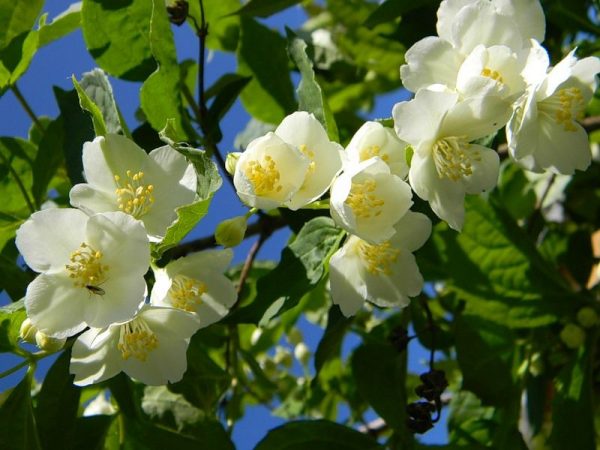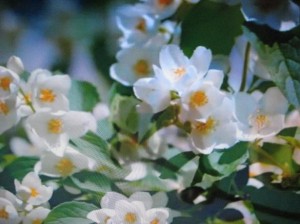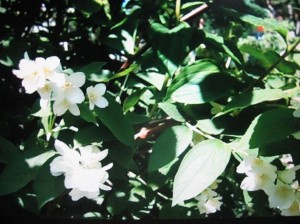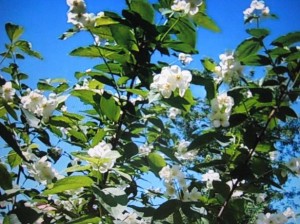Jasmine bush (mock orange) is a slender shrub about two meters high. Its stems are tightly pressed to each other and branch at the top. The leaves are light green, bare or pubescent below. The flowers are quite large, up to 2 - 5 cm. White or cream, very fragrant. It begins to bloom at the end of May and blooms until July. The fruit is a quadrangular capsule with many seeds.
In the wild, jasmine usually settled in river valleys, on alluvial silt soils. However, in terms of soil it is not a demanding crop. This shrub can successfully grow on both sandy loam and loam. But when it is possible to plant it on fertile black soils rich in organic matter, its flowering amazes with its abundance and unique beauty.
Planting jasmine
In the garden, choose a sunny, open place for jasmine. Planting seedlings can be done in spring and autumn, giving preference to the latter in the south. Planting is done in deep holes (50 - 60 cm depth). When planting jasmine, fertilization is mandatory. If the soil is depleted, add a bucket of humus and 0.5 kg of wood ash to the bottom of the planting hole.
In the spring of next year, you should pay special attention to preserving soil moisture. Drying out the land is unacceptable. Watering should be plentiful, but not frequent, the soil should always be in a loose state. Mulching with dry grass, humus, sawdust and so on gives very good results. Before jasmine blooms, it is necessary to fertilize with fertilizers; preference should be given to organic liquid ones. Most suitable are bird droppings or mullein, fermented and then diluted 10 to 20 times with water.
After flowering, it is necessary to give a second fertilizing, phosphorus and potassium, per square meter. meter of area under a bush of superphosphate - 20g, potassium salt - 20g. You can use universal fertilizers for this purpose. The jasmine bush has a fibrous root system that holds a ball of soil well, so it can easily tolerate replanting. It also tolerates heat and high humidity relatively well, but suffers from lack of watering.
Jasmine bush: propagation
Propagating jasmine is not difficult, since the methods are varied. The most productive is by seeds. The seeds in the boxes remain hanging on the bushes all winter, but they must be collected in the fall, since changes in temperature may cause the boxes to crack and the seeds to fall out. Seeds can be planted in spring without stratification. When seedlings appear, the main concern should be watering, since they die very quickly from lack of moisture.
The second effective way to propagate jasmine bushes is through green cuttings. They must be cut during the flowering period or immediately after flowering. The shoot should be non-lignified and at the same time sufficiently mature, its length is about 15 cm. The cuttings are rooted in a moist sandy substrate with constant spraying and maintaining soil moisture. They take root on the 10th - 30th day (depending on the variety).
Jasmine takes root even more easily with wood cuttings, which are cut in the fall during the period of pruning the bush and stored in a cool place in winter. The cuttings are planted in the spring. The jasmine bush also produces root suckers, which are also planting material.
Jasmine pruning
Jasmine is pruned annually, starting at 5-6 years of age, to prolong its life and decorativeness. First of all, old fruit-bearing branches are cut out. The remaining branches must be thinned out, not leaving more than 10 - 15 branches on the bush. Diseased, broken and blind shoots are also cut out. Each growing shoot must receive enough light. Pruning also involves removing faded inflorescences in the upper parts of the shoots during the growing season.
Jasmine bush is a universal plant in ornamental gardening. It can be used in single and group plantings against the background of a lawn, in the design of a gazebo and in the decoration of fences. Serve as a flowering hedge and cover barns and buildings.
The article was written based on materials from the book by L. I. Movsesyan “Growing Ornamental Shrubs”
YOU CAN ALSO READ:
- Forsythia bush
- Barberry planting and care
- Planting remontant raspberries
- Storing Jerusalem artichoke
- How to feed cucumbers
- The most beautiful varieties of lilac




 CUCUMBERS NEVER GET SICK, I'VE BEEN USING ONLY THIS FOR 40 YEARS! I SHARE A SECRET WITH YOU, CUCUMBERS ARE LIKE THE PICTURE!
CUCUMBERS NEVER GET SICK, I'VE BEEN USING ONLY THIS FOR 40 YEARS! I SHARE A SECRET WITH YOU, CUCUMBERS ARE LIKE THE PICTURE! You can dig a bucket of potatoes from each bush. Do you think these are fairy tales? Watch the video
You can dig a bucket of potatoes from each bush. Do you think these are fairy tales? Watch the video
 How our fellow gardeners work in Korea. There is a lot to learn and just fun to watch.
How our fellow gardeners work in Korea. There is a lot to learn and just fun to watch. Eye trainer. The author claims that with daily viewing, vision is restored. They don't charge money for views.
Eye trainer. The author claims that with daily viewing, vision is restored. They don't charge money for views. A 3-ingredient cake recipe in 30 minutes is better than Napoleon. Simple and very tasty.
A 3-ingredient cake recipe in 30 minutes is better than Napoleon. Simple and very tasty. Therapeutic exercises for cervical osteochondrosis.A complete set of exercises.
Therapeutic exercises for cervical osteochondrosis.A complete set of exercises. Which indoor plants match your zodiac sign?
Which indoor plants match your zodiac sign? What about them? Excursion to German dachas.
What about them? Excursion to German dachas.
What beautiful jasmine flowers! It's a shame they fade so quickly
My grandmother has several jasmine bushes. During flowering there is such a scent, you don’t want to leave! I advise everyone to plant this shrub, especially since it doesn’t require any care.
Last summer we planted a tiny jasmine bush in our dacha, but it barely grew over the summer. I really hope he survives the winter. I really want to see it bloom as soon as possible!